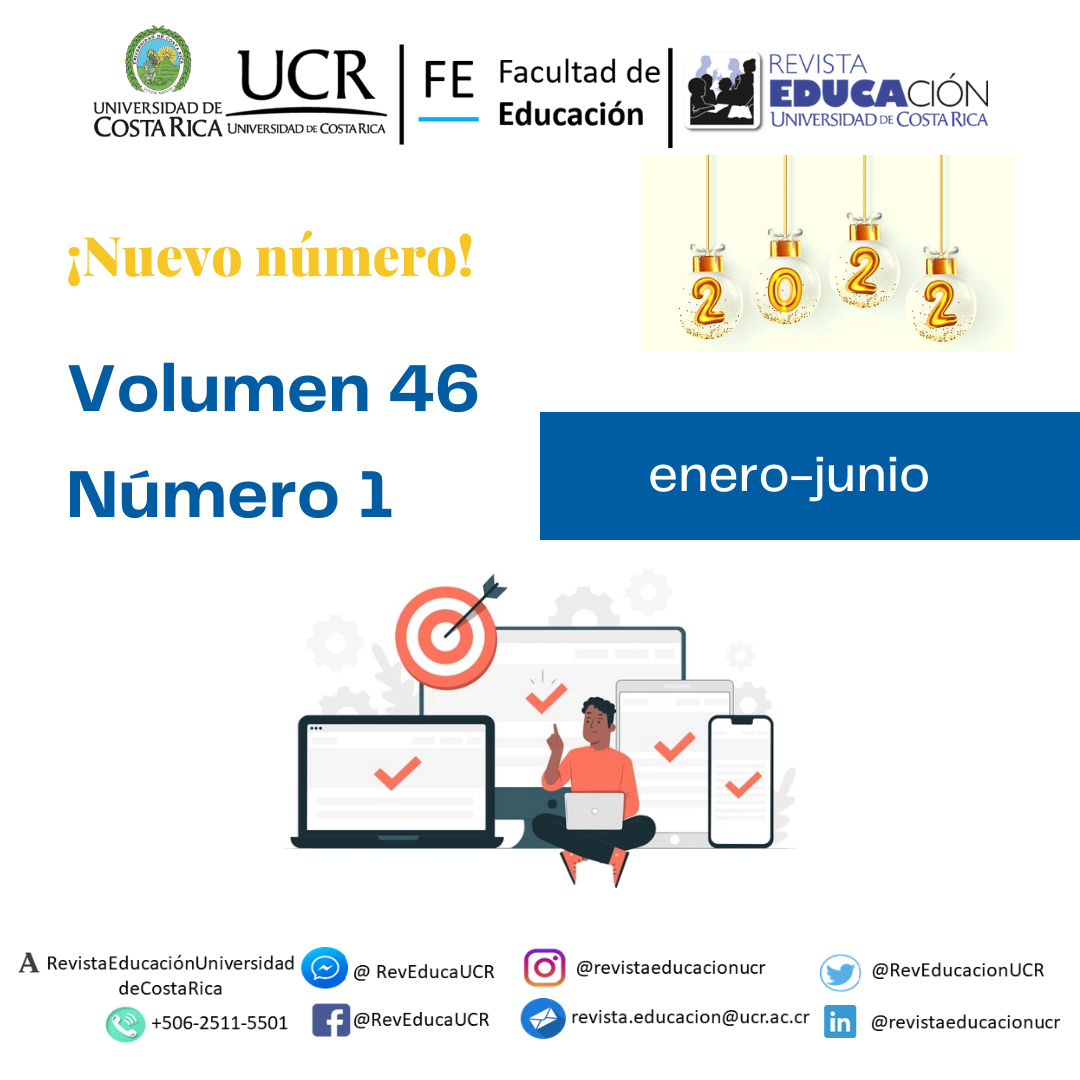Abstract
The objective of the study was to assess items from the standardized test quantitative mathematical skills content database, in order to adapt them and make them accessible to visually impaired individuals who use screen readers. A qualitative and hermeneutic-dialectic, design methodology was used, thereby facilitating the discovery and interpretation of explanations, in-depth interviews with experts to adjust the test items to the screen readers. The study results primarily uncover the importance of analyzing how mathematical symbols and expressions are read and interpreted when using a screen reader.
References
Cómo citar
Ordóñez Gutiérrez, G., Rojas Torres, L. M. Y García Artavia, E. (2022). Elementos para adaptar una prueba de contenido matemático a personas usuarias del lector de pantalla. Revista Educación, 46(1). http://doi.org/10.15517/revedu.v46i1.44773
Referencias bibliográficas
Alfaro-Rojas, L. y Tojas-Torres, L. (2016). Desempeño de personas con adecuación de tiempo adicional en una Prueba Estandarizada. Revista Latinoamericana de Educación Inclusiva, 10(1). 215-227, https://scielo.conicyt.cl/pdf/rlei/v10n1/art11.pdf
Allman, C.B. (2009). Tests access: Making tests accessible for students with visual impairments. A guide for Test Publishers, Test Developers, and State Assessment Personale. (4ta edición) https://sites.aph.org/wp-content/uploads/2017/09/Test-Access-Making-Tests-Accessible-2009.pdf
American Educational Research Association (AERA), American Psychological Association (APA), y National Council on Measurement in Education (NCME). (2014). Standards for Educational and Psychological Testing. American Educational Research Association.
Bernard, H.R. (2011). Research Methods in Anthropology: Qualitative and Quantitative Approaches, (5th ed.). Rowman Altamira.
Buenfil, R. N. (1994). Cardenismo: argumentación y antagonismo en educación. CONACIT /CINVESTAV.
Calhoon, M., Fuchs, L. y Hamlett, C. (2000). Effects of computer-based test accommodations on mathematics performance assessments for secondary students with learning disabilities. Learning Disability Quarterly, 23(4), 271-282. https://doi.org/10.2307/1511349
De Alba, A. (2007). Currículum-Sociedad. El peso de la incertidumbre, la fuerza de la imaginación. Instituto de Investigaciones sobre la Universidad y la Educación.
Folleto de Práctica para la Prueba de Habilidades Cuantitativas. (2018). Universidad de Costa Rica.
Fuchs, L. S., Fuchs, D., Eaton, S.B, Hamlett, C. L. y Karns, K. M. (2000). Supplementing teacher judgments of mathematics test accommodations with objective data sources. School Psychology Review, 29(1), 65-85. https://doi.org/10.1080/02796015.2000.12085998
Gurdián, A. (2007). El paradigma cualitativo en la investigación socio-educativa. Agencia Española de cooperación internacional.
Hansen, E., Mislevy, R., Steinberg, L., Lee, M. y Forer, D. (2005). Accessibility of tests for individuals with disabilities within a validity framework. System 33(1), 107-133. https://doi.org/10.1016/j.system.2004.11.002
Higgins, J. y Katz, M. (2013). A comparison of audio representations of Mathematics content. Journal Special Education Technology. 28(3), 59-66. https://doi.org/10.1177/016264341302800305
Laitusis, C. (2010). Examining the impact of audio presentation on tests of reading comprehension. Applied Measurement in Education, 23(2), 153-167. https://doi.org/10.1080/08957341003673815
Martínez, M. (1999). Comportamiento humano. Editorial Trillas.
Messick, S. (1994). The interplay of evidence and consequences in the validation of performance assessments. Educational Researcher 23(2), 13-23. https://doi.org/10.3102/0013189X023002013
Picado. M.E. (2006). Un acercamiento a la evaluación cualitativa a partir de algunas aristas metodológicas. Editorial de la Universidad de Costa Rica.
Rojas-Torres, L., Alfaro-Rojas. (2014). Análisis de sobrevivencia para la estimación de tiempo adicional como adecuación para la aplicación en un prueba estandarizada. Pensamiento Educativo. Revista de Investigación Educacional Latinoamericana, 51(1), 135-155. https://doi-org/10.7764/PEL.51.1.2014.23
Rojas-Torres, L. y Ordóñez-Gutierrez, G. (2019). Proceso de construcción de pruebas educativas: El caso de la Prueba de Habilidades Cuantitativas. Revista Evaluar, 19(2), 15-29. https://www.kerwa.ucr.ac.cr/handle/10669/82592
Rosenblum, L.P., Cheng, L. y Beal, C.R. (2018). Teachers of students with visual impairments share experiences and advice for supporting students in understanding graphics. Journal of Visual Impairment & Blindness, 112(5), 475-487. https://doi-org/10.1177/0145482X1811200505
Suárez, J. y Castellano, J. (2011). Atención educativa a personas ciega y con baja visión en la Sierra de Cádiz. Clave XXI Reflexiones y Experiencias en Educación, (6), 1-16. http://clave21.ieszaframagon.com/files/articulos/F06_Visual.pdf
Trotter, R. (2012). Qualitative research sample design and sample size: Resolving and unresolved issues and inferential imperatives. Preventive Medicine, (55), 398-400. https://doi.org/10.1016/j.ypmed.2012.07.003
Zebehazy, K. y Wilton, A. (2014). Charting Success: The Experience of Teachers of Students with Visual Impairments in Promoting Student Use of Graphics. Journal of Visual Impairment & Blindness, 108(4), 263-275. https://doi.org/10.1177/0145482X1410800402
Zebehazy, K., Zigmond, N. y Zimmerman, G. (2012). Ability or access-ability: Differential Item Functioning of items on alternate performance-based Assessment tests for students with visual impairments. Journal of Visual Impairment & Blindness, 106(6), 325-338. https://doi.org/10.1177/0145482X1210600602



